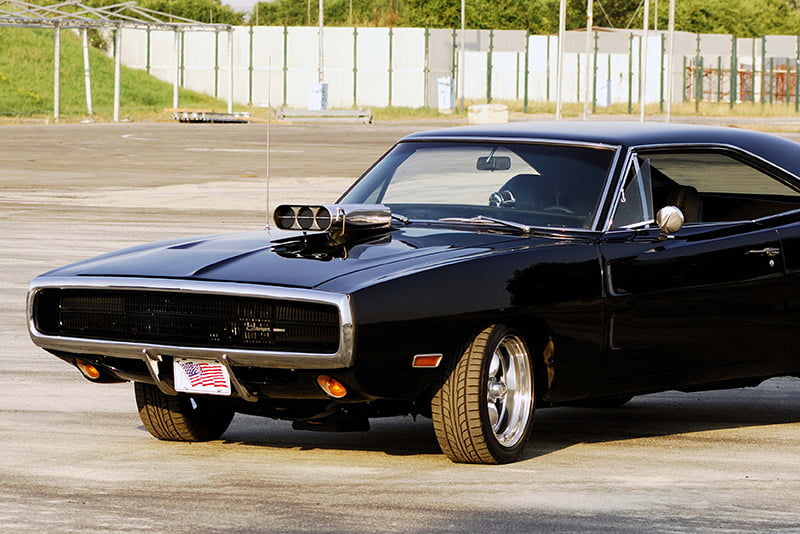If you’re weighing up whether the Dodge Charger vs Challenger is the true king of the muscle cars, it’s important to understand their key differences first.
Used to describe an era of high performance American coupes, muscle cars roared into the market in the early 1960’s as the first mass produced vehicles specifically for drag racing. More or less, muscle cars are an extension of the hot rod philosophy of taking a small car and putting a large-displacement engine in it – all for the purpose of increased straight-line speed.
Although the specifics are often hotly debated, muscle cars usually feature the following:
- Rear wheel drive
- Large V8 engine in the most powerful configuration available for the model
- Manufactured in the United States between 1964 and 1973
- Generally a lightweight, two door body
- An affordable price bracket for it’s time
- Designed for straight line drag racing while still remaining ‘street legal’
The titans of the American muscle car industry featured the usual suspects, such as models released by Ford and Pontiac. In an effort to keep up, Dodge muscle cars arrived on the market in 1964. While Dodge already had a long history in the production of powerful, sophisticated engines and transmissions, they were sitting on a stockpile of ‘old man cars’. However, this image was well and truly shaken off with the release of two of their most famous models, the Dodge Challenger and the Dodge Charger.
Comparing The Dodge Charger vs Challenger
While there’s no doubt that both of these iconic American muscle cars have left quite the impression on auto enthusiasts for quite literally decades, there are a few subtle and not so subtle differences between the two makes. While one should certainly not be considered superior to the other, it’s the little things that can help to determine which would potentially be right for you.
Exterior – One of the most obvious differences when comparing the Dodge Charger vs Challenger is the doors – the former is a four door sedan, while the latter is a two door coupe. In general, the Charger has a more modern look to it. When compared to the Challenger, it does tend to have extra space which gives it a higher roof and rear for more of a street racing-car appearance. In comparison, although it may have updated features, the Challenger still has the classic muscle car look, with its aggressive, tough-looking grille and wide rear.
Interior – While both the Charger and the Challenger seat five people, the Charger tends to do so more comfortably as it has more interior space. While the front rows on both models have similar legroom space, the back row is very much a different story – the Charger has 40.1 inches of legroom and the Challenger has 33.1 inches. On top of that, the Charger has significantly more space in the trunk or boot. While both makes have similar dashboards and general design, it also depends on which year models you are comparing as well.
Performance – When comparing the Dodge Charger vs Challenger, the one thing most revheads want to know is how they stack up against each other in terms of engine size and overall performance. The Charger and Challenger’s biggest differences show at the top trim levels. The Charger’s top trim, the SRT Hellcat, gets 707 horsepower from a 6.2-litre V-8 engine. However, it’s the Challenger that wins the raw power category, with it’s top trim level pulling off 797 horsepower.
Of course, technology has also worked wonders for overall performance, with the most powerful muscle car released to date being the 2018 Dodge Challenger SRT Demon – and it hasn’t been dubbed the Demon without cause. When properly set up, it can accelerate from 0-30 mph in just one second, and smashes a quarter mile in just 9.65 seconds at 140.09 mph. The 6.2 litre V8 engine features a 2.7 litre supercharger, but the catch is that only 3300 were ever made. For better or for worse, it’s evident that Dodge muscle cars will no doubt continue to be revered and in turn modified for future releases.
When it comes down to deciding between these two models based on the price, both the Dodge Challenger and the Dodge Charger have a variety of options that all depend on the vehicle’s year of release, features, and overall condition, particularly if you’re sourcing a vintage model. Thus, it can be extremely helpful to consult with an automotive professional to ensure that you’re on the right track – but where do you find one?
Get To Know Your Local Classic Car Expert
Finding a fellow vintage auto enthusiast can feel a bit like finding a needle in a haystack, but rest assured that Classic’s Garage understands the thrill more than most. Having spent forty years collecting anything and everything from matchbox cars to hub caps, he’s successfully followed his passion to source, collect and stock beautiful and low mileage classic automobiles from around the world. With extensive experience in the automotive industry, it was only a matter of time before Wayne expanded on his love of vintage, iconic vehicles to share his knowledge and passion with the public.
Although his passion is for automobiles built before 1978, with a particular love for Buicks, Cadillacs, Lincolns, Oldsmobiles and even Fords, Wayne is just as passionate about the stories of the owners. Just like the cars, he has found that his fellow classic car enthusiasts all have wildly different attractions and logic behind their passion or hobby, and this often translates into how the car is presented. If it’s even remotely different, rare or just plain unusual, Wayne will overcome the relevant logistical and geographical challenges of bringing the cars to his showroom in Australia.
Classic’s Garage is a showroom conveniently located at Seventeen Mile Rocks, that specialises in the restoration and sales of vintage automobiles. If you’re on the hunt for classic cars in Brisbane – quite simply, Wayne is your man. If you would like to arrange a viewing or inspect any other of our classic vehicles, please get in touch with us today.

